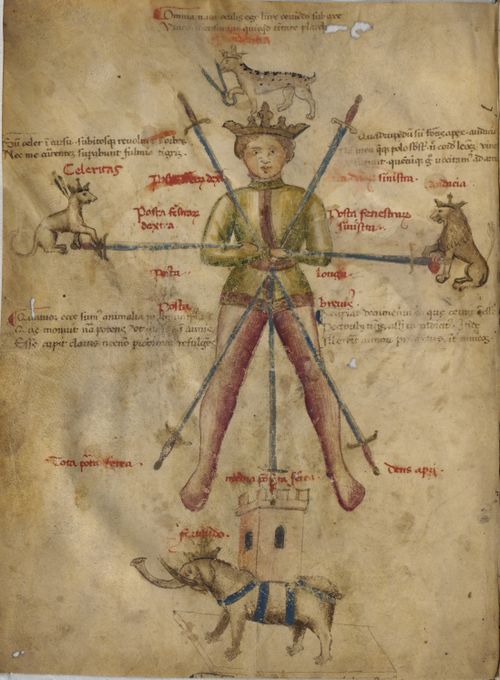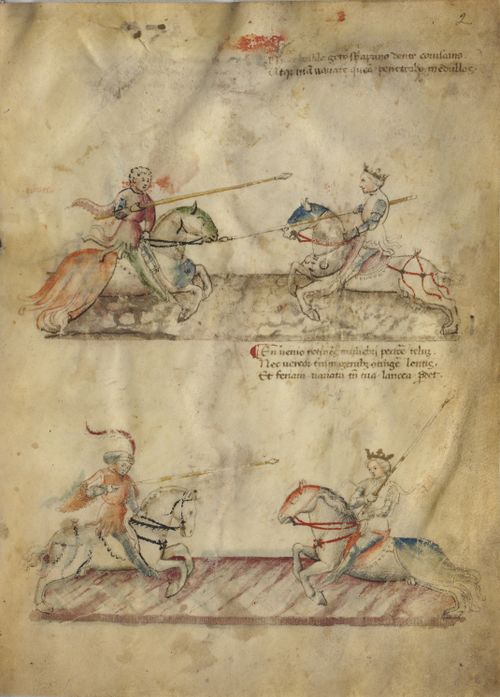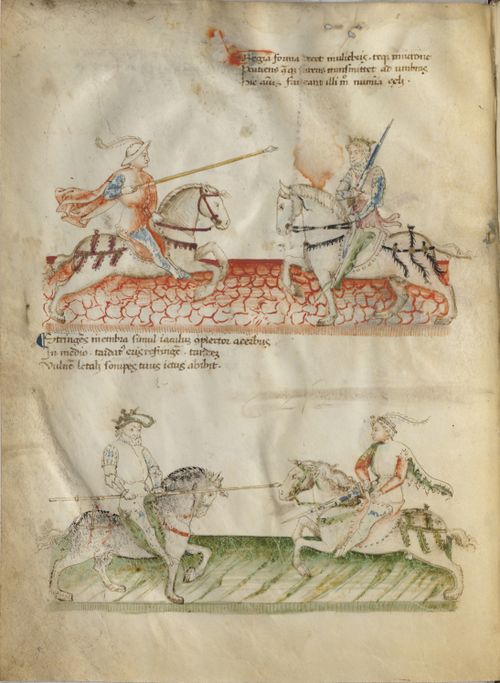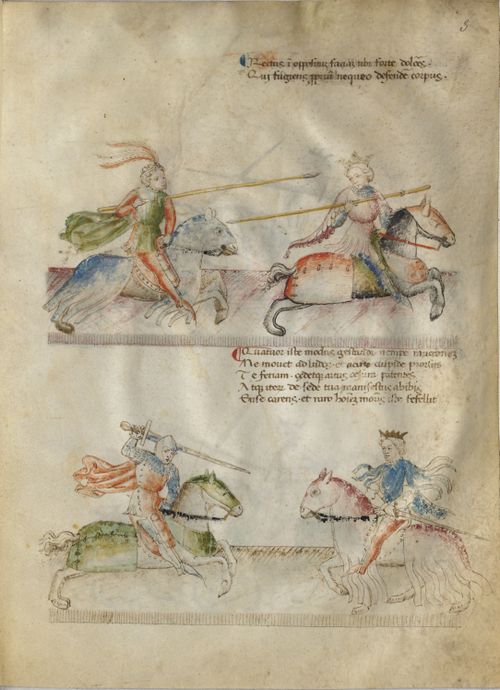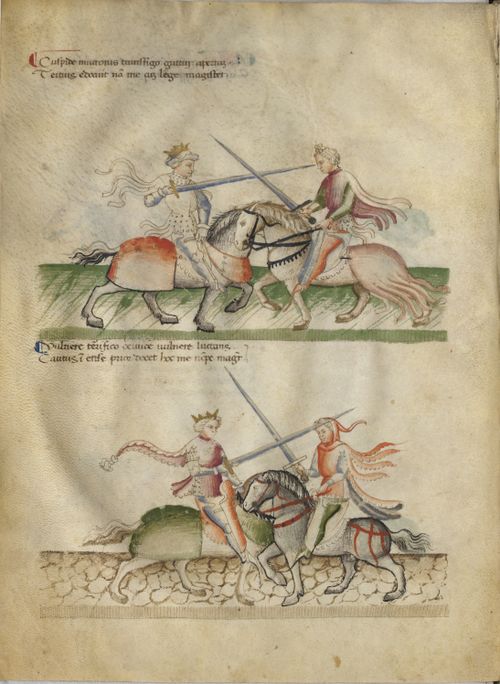|
|
You are not currently logged in. Are you accessing the unsecure (http) portal? Click here to switch to the secure portal. |
Difference between revisions of "User:Kendra Brown/Florius/Side by side"
< User:Kendra Brown | Florius
Jump to navigation
Jump to search
Kendra Brown (talk | contribs) |
Kendra Brown (talk | contribs) |
||
| Line 19: | Line 19: | ||
<div width="550px">{{#lsth:Page:MS Latin 11269 2v.jpg}}</div> | <div width="550px">{{#lsth:Page:MS Latin 11269 2v.jpg}}</div> | ||
<div width="550px"> English goes here </div> | <div width="550px"> English goes here </div> | ||
| − | </div | + | </div> |
==3r== | ==3r== | ||
Revision as of 19:45, 23 August 2022
Contents
1v
¶ Omnia nata oculis ego linx cernendo sub axe
Vinco mensurans quisquod(?) tentare placeb[ ] Prudentia ¶ Sum celer in cursa subitosque revolvem in orbes
Nec me currentem superabunt fulmia tigrim. Celeritas Quadrupedum sum fortis apex, audacia
Non/nam mea quis/uoque polo subsunt. nunc cordus(?) leonem || vincit
[ ] que'cumque ergo gvocitam' ad arma Audacia
Quae monuit nam potens Potuit [...] in armis
Esse cupit clarus necnon probitate refulgens ¶ Accipiat documenta sibi(?) / quae cernit o(?)esse
Pectoribus nuncius affixe indicitus. Inde
Ille erit armorum pr(?) doctus inter amicos.
Posta Dominarum Sinistra
Vinco mensurans quisquod(?) tentare placeb[ ] Prudentia ¶ Sum celer in cursa subitosque revolvem in orbes
Nec me currentem superabunt fulmia tigrim. Celeritas Quadrupedum sum fortis apex, audacia
Non/nam mea quis/uoque polo subsunt. nunc cordus(?) leonem || vincit
[ ] que'cumque ergo gvocitam' ad arma Audacia
Quae monuit nam potens Potuit [...] in armis
Esse cupit clarus necnon probitate refulgens ¶ Accipiat documenta sibi(?) / quae cernit o(?)esse
Pectoribus nuncius affixe indicitus. Inde
Ille erit armorum pr(?) doctus inter amicos.
[below doctus: …et (hand M?)]
[around the master, in red:]
Posta Dominarum Sinistra
Posta fenestrarum dextra
Posta fenestrarum sinistra
Posta longa
Posta brevis
Tota porta ferea
Media porta ferrea
dens apri
English goes here
2r
- ¶ En venio retinens muliebrj pectore telum.
Nec vereor terram genibus contingere lentis.
Et feriam variata tamen tua lancea praedet.
English goes here
2v
- ¶ Regia forma decet muliebris. teque[5] mucrone
Percutiens contra que furens transmittet ad umbras
Hic animus / faveant illi modo numina caeli.
In medio. tardatus eris refringere tandem
Vulnem letali sonipes[7] tuus ictus abibit.
English goes here
3r
English goes here
3v
¶ Cuspide mucronis transfigo guttur apertum
Tertius edocuit nam me cum lege magister.[11]
Cautus in ense prior docet hoc me nempe magister.[14]
Tertius edocuit nam me cum lege magister.[11]
Cautus in ense prior docet hoc me nempe magister.[14]
English goes here
4r
- ¶ Tu pudibundus obhoc ensem vel forte relinques
Vel prostratus humi nullo prohibente iacebis.[15]
Quidque velim de te potero tentare deinde.
English goes here
4v
- ¶ Protego[16] cesura me nunc / ac cuspide forti.
Et capulo[17] faciem ferio / ne prensus hic ensis[18]
Sit mihi / sim terram nec adhuc proiectus ad imam.
Cuius clune / mei pectus fremitando sedebit.
Quadrupedis nec linquo tui resonantia frena[20] /
Donec humum praeceps limosam vertice tangas.
Ista quidem armato valet optima captio / possuntque[21]
Ledere[22] non armis ullum sibi posse pavescit[23]
English goes here
5r
¶ Ut modo tellurem calcato corpore tundas
Est opus . hoc faciunt contraria gesta . malignus
Tu tamen illud idem mihimet tentare cupisti.
English goes here
5v
- ¶ Crure simul stafile levans / te vertet ad imum
Hec mea dextra potens. nec erit quae molliat artus.[26][27]
Qui modo per terram frustra conatus inermem[29]
Spargere[30] tentabas. sed te contraria vincunt .[31]
English goes here
6r
- ¶ Si me rolandus[32] peditem pulicanus[33] et asper
Fraxinea[34] peterent hasta spectando morarer /[35]
Dextraque vel iaculum teneat vel turbida clavam[36].
Atque repercussis feriam furibundior[37] hastis./
Quamprimum hoc actu retraham capita alta prementum.[38]
English goes here
6v
English goes here
7r
English goes here
8v
English goes here
8r
English goes here
8v
English goes here
9r
English goes here
9v
English goes here
10r
English goes here
10v
English goes here
11r
English goes here
11v
English goes here
12r
English goes here
12v
English goes here
13r
English goes here
13v
English goes here
14r
English goes here
1v
English goes here
2r
English goes here
- ↑ The bottom of the page, including the elephant verse, has been cut off.
- ↑ Nunc/mihi in some order?
- ↑ The second line has been over-written to darken worn-away letters. If there were annotations, they have not survived.
- ↑ This pair of verses has a bracket at the end, which has been posited as indicating enjambment of the lines by Mondschein.
- ↑ Added later: "de la pointe".
- ↑ Added later: "remoror [!] jaculum".
- ↑ Added later: "eqqus". Probably meant to be “equus”, but the two q’s are fairly clear.
- ↑ Added later: "ego".
- ↑ This word was obliterated somehow (“et” and “cesura” both show uncorrected damage) but has been written over by a later hand in similarly-colored ink. Further, someone has tried to write something above it, perhaps a French equivalent—the superscript is unreadable, but the second word, above cuspide, appears to end in “te” and could be “pointe”. The superscript above “acute” may have been in the D1 or F hand, but not enough is clear. There may have been a superscript above mucronem that was erased, although the remaining strokes look like they may have suffered the same damage as the rest of the page. None of the superscripts are clear enough to certainly identify the hands.
- ↑ A bracket, similar to the enjambment bracket, hangs off the last line.
- ↑ Enjambment bracket
- ↑ We believe this is "vulnerare" but the condition of the page has elided an abbreviation mark.
- ↑ There is an erasure above “cervice”, but we were not able to discern any letters.
- ↑ Enjambment bracket
- ↑ Enjambment bracket
- ↑ Added later: "te juc g???et".
- ↑ Added later: "de la poignee".
- ↑ There is no enjambment bracket, but the punctuation and text indicate it.
- ↑ Added later: "eqquus".
- ↑ Added later: "te mordé de\per bride".
- ↑ According to Cappelli, p. 257
- ↑ Probably laedere
- ↑ Possible scribal flourish
- ↑ Added later: “??eeu vit”. Could this be “heeume”, misspelling of “heaume”, old french for “helmet”? There are certainly letters beginning above the g in “galea” and reaching to above the e in “prensum”, but we can’t make out enough to guess further. If the latter word is meant to be “heaume”, this must be hand F.
- ↑ Enjambment bracket
- ↑ There is a marginal notation to the right of the verse beginning with +. The marginal note seems likely to be hand F, but the + may be from one of the Latin hands. My best guess: ??a??e tram ? perm
- ↑ Enjambment bracket
- ↑ Added later: "pro tui".
- ↑ Added later: "scilicet".
- ↑ or 'Si pargere', but Rebecca says there is a scribal practice for separating the first letter of a line in this manner.
- ↑ Enjambment bracket
- ↑ Added later: "nomen properum". Partially obliterated
- ↑ Added later: "nomen properum".
- ↑ Added later: "de fresne".
- ↑ To the right of the first two lines, there appear to be three lines of smudgy pencil (most likely M or F), but nothing specific can be made out.
- ↑ Added later: "matreque?".
- ↑ Added later: "four words that might be latin".
- ↑ There is no enjambment bracket, but grammar and syntax led to enjambment in the translation.
- ↑ Possibly "maestum"
- ↑ Enjambment bracket
- ↑ The bottom of the page, including the elephant verse, has been cut off.
- ↑ Nunc/mihi in some order?
- ↑ The second line has been over-written to darken worn-away letters. If there were annotations, they have not survived.
- ↑ This pair of verses has a bracket at the end, which has been posited as indicating enjambment of the lines by Mondschein.
- ↑ The bottom of the page, including the elephant verse, has been cut off.
- ↑ Nunc/mihi in some order?
- ↑ The second line has been over-written to darken worn-away letters. If there were annotations, they have not survived.
- ↑ This pair of verses has a bracket at the end, which has been posited as indicating enjambment of the lines by Mondschein.
- ↑ The bottom of the page, including the elephant verse, has been cut off.
- ↑ Nunc/mihi in some order?
- ↑ The second line has been over-written to darken worn-away letters. If there were annotations, they have not survived.
- ↑ This pair of verses has a bracket at the end, which has been posited as indicating enjambment of the lines by Mondschein.
- ↑ The bottom of the page, including the elephant verse, has been cut off.
- ↑ Nunc/mihi in some order?
- ↑ The second line has been over-written to darken worn-away letters. If there were annotations, they have not survived.
- ↑ This pair of verses has a bracket at the end, which has been posited as indicating enjambment of the lines by Mondschein.
- ↑ The bottom of the page, including the elephant verse, has been cut off.
- ↑ Nunc/mihi in some order?
- ↑ The second line has been over-written to darken worn-away letters. If there were annotations, they have not survived.
- ↑ This pair of verses has a bracket at the end, which has been posited as indicating enjambment of the lines by Mondschein.
- ↑ The bottom of the page, including the elephant verse, has been cut off.
- ↑ Nunc/mihi in some order?
- ↑ The second line has been over-written to darken worn-away letters. If there were annotations, they have not survived.
- ↑ This pair of verses has a bracket at the end, which has been posited as indicating enjambment of the lines by Mondschein.
- ↑ The bottom of the page, including the elephant verse, has been cut off.
- ↑ Nunc/mihi in some order?
- ↑ The second line has been over-written to darken worn-away letters. If there were annotations, they have not survived.
- ↑ This pair of verses has a bracket at the end, which has been posited as indicating enjambment of the lines by Mondschein.
- ↑ The bottom of the page, including the elephant verse, has been cut off.
- ↑ Nunc/mihi in some order?
- ↑ The second line has been over-written to darken worn-away letters. If there were annotations, they have not survived.
- ↑ This pair of verses has a bracket at the end, which has been posited as indicating enjambment of the lines by Mondschein.
- ↑ The bottom of the page, including the elephant verse, has been cut off.
- ↑ Nunc/mihi in some order?
- ↑ The second line has been over-written to darken worn-away letters. If there were annotations, they have not survived.
- ↑ This pair of verses has a bracket at the end, which has been posited as indicating enjambment of the lines by Mondschein.

